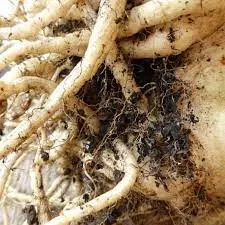If you're a passionate gardener or plant enthusiast, you understand the vital role that a healthy root system plays in the well-being of your plants. Unfortunately, one of the most formidable adversaries of a plant's roots is root rot, a fungal disease that can devastate your garden if left unchecked. In this blog post, we'll delve into understanding root rot, its symptoms, strategies for prevention, and how to treat it effectively. We'll also explore the use of fungicides, including Trichoderma viride, to help protect your garden.
Understanding Root Rots
Root rot is a collective term that encompasses various fungal infections that target a plant's
root system. These fungi thrive in damp, poorly drained soils, posing a significant threat, especially during rainy seasons or in gardens prone to overwatering. Common culprits include Rhizoctonia, Pythium, and Phytophthora.Recognizing the Symptoms
To effectively combat root rot, it's essential to identify its early warning signs:
1. Yellowing or Wilting Leaves: One of the initial symptoms of root rot is the yellowing or wilting of a plant's leaves. This occurs because the compromised roots can't supply sufficient water and nutrients to the rest of the plant.
2. Stunted Growth: Infected plants often exhibit slow or stunted growth due to their weakened root systems.
3. Brown, Spongy Roots: Examination of the roots reveals a brown or blackish color and a spongy, deteriorated texture. In contrast, healthy roots should be firm and white.
4. Foul Odor: In advanced cases, a putrid odor reminiscent of decaying matter may emerge, signaling severe root decay.
Prevention: The First Line of Defense
Preventing root rot is more effective than treating it. Employ these strategies to protect your plants:
1. Well-Draining Soil: Ensure your plants are situated in well-draining soil to prevent waterlogging, a condition that promotes root rot development.
2. Prudent Watering: Avoid overwatering by allowing the topsoil to dry slightly between watering.
3. Prune Infected Parts: Promptly remove and dispose of any affected plant material to prevent the disease from spreading.
4. Choose Resistant Plants: When planning your garden, select plant varieties that are less susceptible to root rot.
Curative Treatment
If you suspect root rot or have confirmed its presence, it's crucial to act promptly:
1. Trim Affected Areas: Trim away and discard any infected roots and plant material, ensuring your pruning tools are sanitized to prevent further spread.
2. Repot the Plant: Replant the affected plant in fresh, well-draining soil, and consider using a new container to prevent recontamination.
Fighting Back with Fungicides
Fungicides are valuable allies in the battle against root rot. These chemical treatments can be employed both preventively and as a curative measure. Here are some effective fungicides, including Trichoderma viride:
1. Neem Oil: Neem oil is a natural fungicide that disrupts the fungal life cycle and inhibits its growth. It can be used preventively and as a curative treatment.
2. Copper-Based Fungicides:** Products like Bordeaux mixture or copper hydroxide are effective against various fungal diseases, including root rot. They can be used preventively and as curative treatments.
3. Thiophanate-Methyl (Cleary's 3336): As a systemic fungicide, thiophanate-methyl can treat root rot when applied as directed. It suppresses fungal growth and spreads within the plant.
4. Fosetyl-Al (Aliette): Another systemic fungicide, fosetyl-al can be applied as a curative treatment for root rot. It's absorbed by the plant and helps suppress fungal growth.
5. Trichoderma viride: This beneficial fungus can be applied preventively by mixing it into the soil. It forms a protective barrier around the roots and outcompetes harmful fungi. As a curative treatment, it can be applied as a root drench or incorporated into the soil to combat root rot pathogens.
Using Fungicides: A Step-by-Step Guide
When using fungicides, follow these general steps:
1. Read the Label: Always read and follow the instructions on the fungicide product label carefully. Application methods and dosages may vary by product.
2. Safety First: Wear appropriate protective gear, such as gloves and eye protection, when handling fungicides.
3. Prepare the Solution: Mix the fungicide according to the manufacturer's instructions, using the recommended concentration.
4. Application: Apply the fungicide to the affected plant or soil as directed on the label. Ensure thorough coverage, especially around the root zone.
5. Repeat if Necessary: Some treatments may require multiple applications, so adhere to the recommended schedule.
By following these guidelines and using the appropriate fungicides, such as Trichoderma viride, you can effectively prevent and treat root rot, safeguarding your garden's health and vitality. Remember that early detection, proactive measures, and the right fungicides are your best allies in defeating this fungal menace.

Comments
Post a Comment